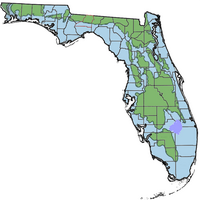

The Thomas Farm site is an Early Miocene, Hemingfordian assemblage of vertebrate fossils located in Gilchrist County, northern Florida.
The Thomas Farm site is one of the richest terrestrial deposits of Miocene vertebrates in the 18 Ma range found in eastern North America according to the Florida Museum of Natural History. The site was discovered in 1931 by Florida Geological Survey (FGS) staff member Clarence Simpson. Specimens include: amphibians, reptiles, birds, small rodents, bats, rhinoceroses, three species of three-toed horses, several artiodactyls (including camels, peccary, deer-like species and other extinct forms), as well as dogs, bears, and bear-dogs.
Specimens
Reptilia
- Pseudemys sp.
- Testudo (T. tedwhitei)
- Promilio (P. epileus)
- Promilio (P. brodkorbi)
- Proictinia (P. floridana)
- Alligator (A. olseni)
- Paraoxybelis (P. floridanus)
- Pseudocemophora (P. antiqua)
- Anilioides (A. minuatus)
- Pseudoepicrates (P. stanolseni)
- Ogmophis (O. pauperrimus
- Calamagras (C. floridanus)
Birds
Phalacrocoracidae
- Phalacrocorax (P. subvolans)
Columbidae
Mammals
Rhinocerotidae
- Diceratherium (D. barbouri)
- Floridaceras (F. whitei)
Equidae
- Parahippus (P. leonensis)
- Anchitherium (A. clarencei)
Amphicyonidae
Ursidae
- Aelurodon (A. johnhenryi)
- Phoberocyon (johnhenryi)
Mustelidae
- Mephitaxus (M. ancipidens)
- Miomustela
- Zodiolestes (Z. freundi)
- Oligobunis (O. floridanus)
Canidae
- Osbornodon iamonensis
- Euoplocyon (E. spissidens)
- Metatomarctus (M. canavus)
- Aelurocyon (A. spissidens)
- Phlaocyon sp.
Chiroptera
- Chiroptera sp.
- Primonatalus (P. prattae)
- Karstala (K. silva)
- Miomyotis (M. floridanus)
- Svaptenos (S. whitei)
Artiodactyla
- Floridachoerus (F. olseni)
- Machaeromeryx (M. gilchristensis)
- Parablastomeryx (P. floridanus)
- Merycoidodon sp.
- Syndyoceras (S. australis)
- Floridatragulus (F. dolichanthereus)
- Oxydactylus (O. floridanus)
- Nothokemas (N. floridanus)
Soricidae
- Limnoecus sp.
Rodentia
- Cricetidae
- Proheteromys (P. magnus)
- Proheteromys P. floridanus)
- Miospermophilus
- Nototamias (N. hulberti)
- Petauristodon (P. pattersoni)
- Mesogaulus
- Mylagaulidae
Amphibians
- Proacris (P. mintoni)
- Proacris mintoni
References
- "Thomas Farm". Florida Museum. 2017-03-28. Retrieved 2021-09-06.
- Hulbert Jr., Richard C. (January 30, 2009). "Thomas Farm". Florida Vertebrate Fossils. Retrieved 2024-11-08.
- Florida Museum of Natural History: Thomas Farm site
- Pratt, Ann E.; Morgan, Gary S. (1989). "New Sciuridae (Mammalia: Rodentia) from the Early Miocene Thomas Farm Local Fauna, Florida". Journal of Vertebrate Paleontology. 9 (1): 89–100. ISSN 0272-4634.
- Czaplewski, Nicholas J.; Morgan, Gary S. (2001). "A New Vespertilionid Bat (Mammalia: Chiroptera) from the Early Miocene (Hemingfordian) of Florida, USA". Journal of Vertebrate Paleontology. 20 (4): 736–742. ISSN 0272-4634.
- Morgan, Gary S.; Czaplewski, Nicholas J. (2003). "A New Bat (Chiroptera: Natalidae) from the Early Miocene of Florida, with Comments on Natalid Phylogeny". Journal of Mammalogy. 84 (2): 729–752. ISSN 0022-2372.
- Hulbert, Richard C. (1984). "Paleoecology and Population Dynamics of the Early Miocene (Hemingfordian) Horse Parahippus Leonensis from the Thomas Farm Site, Florida". Journal of Vertebrate Paleontology. 4 (4): 547–558. ISSN 0272-4634.
- O'sullivan, Jay A. (2003). "A New Species of Archaeohippus (Mammalia, Equidae) from the Arikareean of Central Florida". Journal of Vertebrate Paleontology. 23 (4): 877–885. ISSN 0272-4634.
- Lloyd, Robin. "An Inside Look at an 18 Million-year-old Fossil Dig Site in Florida". Scientific American Blog Network. Retrieved 2021-09-06.
- Martin, Robert A. (1969). Fossil mammals of the coleman ILA local fauna, Sumter County, Florida.
- Olsen, S. J. (1962). "The Thomas Farm Fossil Quarry". Quarterly Journal of the Florida Academy of Sciences. 25 (2): 142–146. ISSN 0015-3850.
- Romer, Alfred Sherwood (1947). "The Fossil Mammals of Thomas Farm, Gilchrist County, Florida". Quarterly Journal of the Florida Academy of Sciences. 10 (1): 1–11. ISSN 0015-3850.
29°51′57″N 82°51′47″W / 29.8658°N 82.8631°W / 29.8658; -82.8631
Categories: